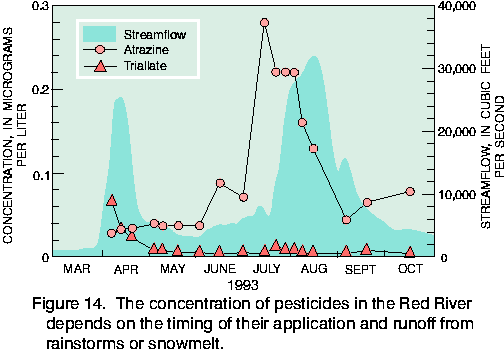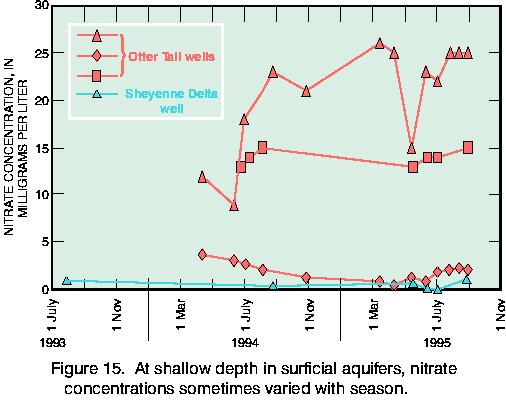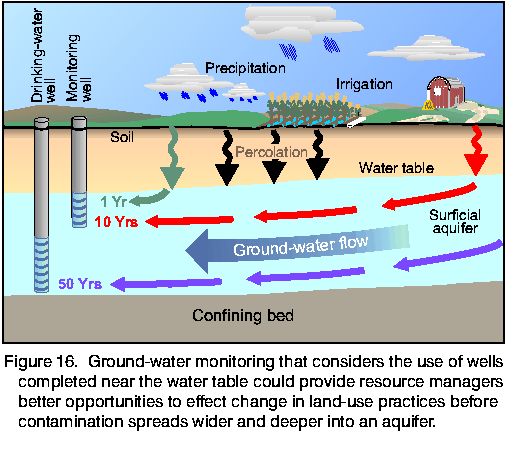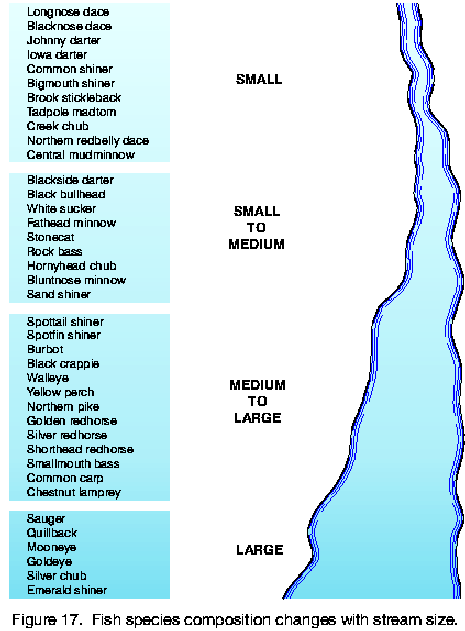MAJOR ISSUES AND FINDINGS
(F) Importance of Variations in Water Quality
Water-quality criteria and indicators used for monitoring and overall management of contamination sources for water resources in this basin could be enhanced by considering the water-quality effects of variation by sub-region, hydrologic conditions, and season.
Nitrate concentrations
in streams tended to be highest in the central subregion of the Study Unit (Tornes and others, 1997) where fertilizer
application was the greatest (Tornes and
Brigham, 1994). Total phosphorus also was higher in the central
subregion than in the other subregions (Tornes
and others, 1997). Atrazine and associated herbicides were detected mostly in the
southern part of the basin where corn is a major crop. Streams in the western
subregion had the highest concentrations of sulfate and usually the highest
concentrations of dissolved solids. Dissolved-solids concentrations ranged from 300
mg/L in the upper Otter Tail River to about 800 mg/L in the Bois de Sioux
River (Tornes and others, 1997).
This study was conducted during a period of relatively wet hydrologic
conditions. These wet conditions enabled some definition of water quality
during high streamflows and ground-water recharge. However, without comparable historical data, the specific effects of these wet conditions cannot be quantified.
Much of the temporal variation in water quality is seasonal. Seasonally,
winter brings cold temperatures, snow, and ice. Surface waters tend to have
less dissolved oxygen, lower concentrations of suspended sediment, and higher
concentrations of nutrients than during other seasons. Ammonia and dissolved phosphorus
concentrations can be high under ice conditions. Typical concentration of
dissolved oxygen under ice was 0.1 mg/L in the Red River (Tornes and others, 1997).
Spring brings cool temperatures, melting snow and ice, flooded fields, and
high flows in rivers with corresponding increases in dissolved-oxygen,
suspended-sediment, and nutrient concentrations. Snowmelt and precipitation
runoff delivers nutrients, pesticides, and sediment to streams. Soil
preparation and the application of chemicals relative to the occurrence of
precipitation accounts for some of the variability in the amount of
contaminants that reached Study Unit streams. Agricultural chemicals such as
triallate, a herbicide applied in the fall, may reach their highest
concentrations during spring (Tornes and Brigham, 1995) (fig. 14).

Summer brings warm temperatures, thunderstorms, and generally declining water levels in rivers. The periodic rainstorms increase suspended sediment and transport pesticides applied in spring and summer to surface waters.
Fall brings cool temperatures, falling leaves, and low stream-water levels.
Streamflows approach the annual minimum during fall (Stoner and others, 1993). Reduced flows generally correspond to reduced suspended-sediment, nutrient, and pesticide concentrations.
Detailed studies of cropland effects on the quality of water in shallow surficial
aquifers (Otter Tail and Sheyenne Delta study areas, p. 22) showed
significant differences in pesticide presence and nitrate concentrations with
location, season, and depth (Cowdery, 1997).
The median
nitrate concentrations in ground water from the Otter Tail study were higher than from the Sheyenne Delta study: 6.1 mg/L compared to 0.03 mg/L, respectively. More pesticides were detected for the Otter Tail study and at higher concentrations than for the Sheyenne Delta study. The water-quality difference was related to differences in total nitrogen application to cropland (estimated at 52 and 23 pounds per acre per year, respectively) and slight differences in hydrologic and soil conditions among the aquifer settings. Although land use in both areas was similar, the Otter Tail aquifer received more recharge because of coarser textured soils and generally more irrigation.
Seasonal differences in nitrate concentrations in the upper 5 to 10 feet of these surficial aquifers were related in part to the timing of significant recharge periods that generally coincided with spring snowmelt and major summer rainstorms. This variable recharge, in conjunction with variations in the timing and application of fertilizer applied to each crop, results in complex changes in nitrate concentrations over time in shallow depths in these aquifers (fig. 15). Similar temporal variability in pesticide presence also might be expected. This information could be used in the design of ground-water monitoring of surficial aquifers for the purpose of checking the progress of land-management practices.

Many privately owned drinking-water wells used in the Otter Tail and Sheyenne
Delta aquifers are deeper than the monitoring wells from this study and
produced water that was safe to drink. Water quality near the water table was
affected by the land-use activities because of relatively recent recharge (1
to 10 years). The quality of the deeper ground water was older (greater than
20 years) and was therefore less affected by the relatively recent land-use
practices and recharge (Stoner and others, 1997, and fig. 16).

Fish community composition correlated well with stream size, habitat
availability, and hydrologic variability, but not with geographic provinces
and ecoregions (Goldstein and others, 1996b). Species in small streams, medium streams, and large rivers tend to differ (fig. 17). The source of species for tributary streams was the Red River, so any given species has potential access to most tributaries. The number of fish species (one measure of community health) increased with the size of streams and the number of ecoregions through which a stream flowed (Goldstein, 1995). Approximately 60 percent of the variability in fish community composition can be attributed to factors such as habitat, streamflow, water temperature, minimum dissolved-oxygen concentration, nutrients, and suspended sediment (Goldstein and others, 1996b). Additional variation was due to both human influence from land-use practices and biological interactions (competition, predation, disease, and parasitism) (Goldstein and others, 1996b). No patterns could be found to interpret cause-and-effect relations. Biological communities have adapted to take advantage of the environmental conditions that occur during each season: increased habitat volume and dissolved-oxygen concentrations during the spring for reproduction; increased water temperatures and productivity during summer for growth; lower water levels during fall for concentration of prey; and reduced activity and return to deep-water refuges during low water and dissolved-oxygen concentrations in winter (Goldstein and others, 1996b). A biological monitoring program (Niemela and others, in press) that relies on periodically sampling communities under the same seasonal environmental conditions has been developed for the Red River Basin Study Unit.



